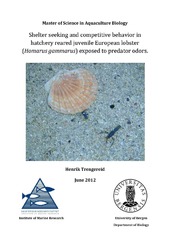| dc.description.abstract | Releases of hatchery reared juvenile European lobster have been performed throughout Europe since the 19th century. However, poor survival in the wild reduces the success of both stock enhancement programs and large-scale sea-ranching. Predation on released naïve juveniles is substantial and presumably caused by behavioral deficiencies due to an impoverished rearing environment. Lobsters can recognize and discriminate between different chemical cues and modulate their behavior accordingly. This is assumed to also be true for odors related to potential predators. In the present study, shelter-seeking and competitive behavior was investigated after a series of exposures to a mix of predator odors. Odor exposure was hypothesized to serve as a form of habitat enrichment, acting as an induced predation pressure increasing the lobsters' motivation to find and compete for shelter. Three experiments were conducted in test-environments of gradually increasing complexity. Behavioral assays on individual lobsters in a small and relatively low-complexity test-environment indicated no effects of odor exposure on shelter-seeking or general activity level. In contrast, when allowing for intraspecific competition in the same environment, lobsters exposed to predator odors were significantly more adept at gaining dominance, evident as superior ability to win agonistic interactions. The winners also spent more time in shelter, less time on roaming and displayed less freezing behavior than the losing opponent. Interestingly, interactions were initiated by naïve lobsters significantly more often than lobsters that had experienced predator odors. When performing a small-scale simulated release in a more comprehensive and diverse semi-natural environment, naïve lobsters initially performed better than those exposed to predator odors. However, the exposed lobsters significantly increased shelter occupancy as the experiment progressed over a 35-day period, whereas the opposite was true for naïve lobsters. The results suggest that there is a long-lasting effect of prolonged odor exposure, but it is only manifested as altered behavior in the presence of environmental triggers. Reasons for the apparent long term effects are discussed, and it is suggested that prolonged exposure to predator odors may either positively influence behavioral plasticity through chemical enhancement, or elevate the lobsters' underlying fright-related motivation in competing for shelter. Further studies are needed to confirm an effect of odor exposure in a more realistic release setting, ideally performed as a small-scale release in natural lobster habitats with predators present to assess natural predator-avoiding behavior. | en_US |
